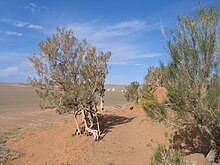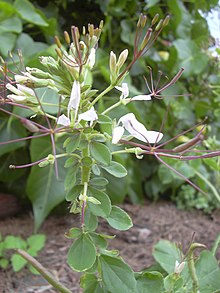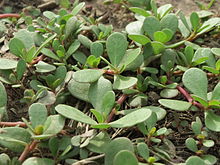
In botany, C4 carbon fixation is one of three known methods of photosynthesis used by plants. C4 plants increase their photosynthetic efficiency by reducing or suppressing photorespiration, which mainly occurs under low atmospheric CO2 concentration, high light, high temperature, drought, and salinity.[2][3] There are roughly 8,100 known C4 species, which belong to at least 61 distinct evolutionary lineages in 19 families (as per APG IV classification[4]) of flowering plants.[1] Among these are important crops such as maize, sorghum and sugarcane, but also weeds and invasive plants.[1] Although only 3% of flowering plant species use C4 carbon fixation, they account for 23% of global primary production.[5] The repeated, convergent C4 evolution from C3 ancestors has spurred hopes to bio-engineer the C4 pathway into C3 crops such as rice.[1][5]
C4 photosynthesis probably first evolved 30–35 million years ago in the Oligocene, and further origins occurred since, most of them in the last 15 million years. C4 plants are mainly found in tropical and warm-temperate regions, predominantly in open grasslands where they are often dominant. While most are graminoids, other growth forms such as forbs, vines, shrubs, and even some trees and aquatic plants are also known among C4 plants.[1]
C4 plants are usually identified by their higher 13C/12C isotopic ratio compared to C3 plants or their typical leaf anatomy.[5] The distribution of C4 lineages among plants has been determined through phylogenetics and was considered well known as of 2016[update]. Monocots – mainly grasses (Poaceae) and sedges (Cyperaceae) – account for around 80% of C4 species, but they are also found in the eudicots.[1] Moreover, almost all C4 plants are herbaceus, with the notable exception of some woody species from the Euphorbia genus, such as the tree Euphorbia olowaluana.[6] The reason behind C4 metabolism extreme rarity in trees is debated: hypotheses vary from a possible reduction in photosynthetic quantum yield under dense canopy conditions, coupled with an increased metabolic energy consumption (inherent to C4 metabolism itself), to less efficient sunflecks utilization.[7]
The following list presents known C4 lineages by family, based on the overview by Sage (2016).[1] They correspond to single species or clades thought to have acquired the C4 pathway independently. In some lineages that also include C3 and C3–C4 intermediate species, the C4 pathway may have evolved more than once.[1]











- ^ a b c d e f g h i j k l m n o p Cite error: The named reference
Sage2016was invoked but never defined (see the help page). - ^ Cite error: The named reference
SageSage2012was invoked but never defined (see the help page). - ^ Cite error: The named reference
ChristinOsborne2014was invoked but never defined (see the help page). - ^ Cite error: The named reference
APGIVwas invoked but never defined (see the help page). - ^ a b c Cite error: The named reference
Kellogg2013was invoked but never defined (see the help page). - ^ Elliott, Liam (2020-05-22). "To C4 or not to C4 if you're a tree? Some possible answers". Botany One. Retrieved 2024-04-30.
- ^ Young, Sophie N R.; Sack, Lawren; Sporck-Koehler, Margaret J.; Lundgren, Marjorie R. (2020). "Why is C4 photosynthesis so rare in trees?". Journal of Experimental Botany. 71 (16): 4629–4638. doi:10.1093/jxb/eraa234. PMC 7410182. PMID 32409834. Retrieved 2024-05-01.
- ^ Cite error: The named reference
YangBerry2011was invoked but never defined (see the help page). - ^ Cite error: The named reference
KochKennedy1982was invoked but never defined (see the help page).